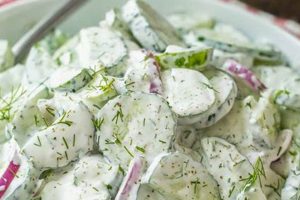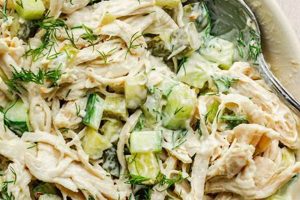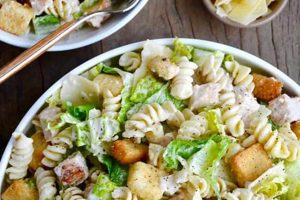A combination of cooked chicken, mayonnaise, grapes, and walnuts creates a classic American salad. Variations may include different types of grapes (red, green, or a mix), toasted or candied walnuts, and additional ingredients such as celery, onion, or dried cranberries. This blend offers a balance of savory and sweet flavors, with the creamy dressing complementing the crunch of the nuts and the juicy burst of the grapes.
This particular salad combination offers nutritional value with lean protein from the chicken, healthy fats from the walnuts, and antioxidants from the grapes. Its versatility makes it suitable for a light lunch, a picnic dish, or as a filling for sandwiches or wraps. Historically, chicken salad became popular in the mid-19th century, evolving from simple combinations to more elaborate recipes incorporating fruits and nuts. The inclusion of grapes and walnuts adds textural and flavor complexity, elevating the dish beyond a basic chicken salad.
Further exploration could delve into specific recipe variations, nutritional information, tips for ingredient selection and preparation, and suitable pairings with other dishes or beverages. Different culinary traditions and regional variations could also be examined, providing a deeper understanding of this widely enjoyed dish.
Tips for a Superior Chicken Salad with Grapes and Walnuts
Optimizing ingredient selection and preparation techniques elevates this classic dish. Attention to detail ensures a balanced flavor profile and desirable texture.
Tip 1: Poaching Chicken for Optimal Flavor: Poaching chicken breasts results in tender, flavorful meat ideal for salad. Avoid overcooking, which can lead to dry, stringy texture.
Tip 2: Toasting Walnuts for Enhanced Flavor: Toasting walnuts intensifies their nutty flavor and adds a satisfying crunch. Spread them on a baking sheet and toast lightly in a preheated oven or dry skillet.
Tip 3: Selecting Grapes: Seedless grapes, whether red, green, or a mix, offer convenience and prevent unwanted bitterness. Halving larger grapes ensures even distribution throughout the salad.
Tip 4: Balancing Sweetness and Tang: A touch of acidity enhances the sweetness of the grapes. A squeeze of lemon juice or a dash of apple cider vinegar achieves this balance.
Tip 5: Mayonnaise Selection and Customization: High-quality mayonnaise forms the base of the dressing. Plain mayonnaise allows for customization with seasonings. Greek yogurt can be incorporated for a lighter, tangier alternative.
Tip 6: Seasoning and Fresh Herbs: Freshly ground black pepper, salt, and a pinch of celery salt enhance the savory notes. Fresh herbs, such as dill or chives, add a bright, aromatic dimension.
Tip 7: Chilling for Optimal Flavor Development: Allowing the salad to chill in the refrigerator for at least 30 minutes allows the flavors to meld and the salad to firm up, improving its texture.
By following these tips, one can create a chicken salad that showcases the harmonious blend of flavors and textures, ensuring a delightful culinary experience.
These guidelines provide a foundation for crafting a truly exceptional chicken salad. Experimentation with different ingredient combinations and flavor profiles allows for personalized variations.
1. Chicken (cooked, diced)
Cooked, diced chicken forms the foundational protein component of chicken salad incorporating grapes and walnuts. The preparation and quality of the chicken significantly influence the final dish’s overall taste and texture.
- Cooking Method:
Various cooking methods, such as poaching, grilling, roasting, or baking, yield different flavor profiles and textures. Poaching results in tender, moist chicken ideal for salad, while grilling imparts a smoky char. The chosen method impacts the salad’s overall character.
- Dicing Technique:
Uniformly dicing the chicken ensures even distribution throughout the salad and consistent bite size. Overly large pieces can disrupt the balance, while excessively small pieces may result in a mushy texture. Precise dicing contributes to both aesthetics and palatable texture.
- Chicken Quality:
The quality of the chicken directly affects the salad’s flavor. Free-range or organic chicken often possesses a richer, more pronounced taste. Selecting high-quality chicken enhances the overall culinary experience.
- Seasoning during Cooking:
Seasoning the chicken during the cooking process, rather than solely relying on seasoning the finished salad, infuses the meat with flavor, contributing depth to the final dish. This proactive approach elevates the overall taste profile.
These considerations regarding the chicken’s preparation contribute significantly to the overall success of the chicken salad recipe with grapes and walnuts. Careful attention to cooking method, dicing technique, chicken quality, and preemptive seasoning ensures a flavorful and texturally satisfying final product.
2. Mayonnaise (quality binder)
Mayonnaise serves as the unifying element in chicken salad, binding the diverse ingredients into a cohesive whole. Its quality and characteristics significantly influence the final product’s texture, flavor, and overall appeal within the “chicken salad recipe grapes walnuts” context.
- Emulsification and Texture:
Mayonnaise, an emulsion of oil and egg yolks, provides the creamy texture characteristic of chicken salad. A stable emulsion prevents separation and ensures a smooth, consistent mouthfeel. Instability leads to a greasy or watery consistency, negatively impacting the salad’s palatability.
- Flavor Profile:
Mayonnaise contributes a tangy, rich flavor that complements the other ingredients. High-quality mayonnaise, made with fresh ingredients, offers a more nuanced flavor profile compared to mass-produced versions. This subtle tang enhances the sweetness of the grapes and the savory notes of the chicken and walnuts.
- Binding Capacity:
The binding capacity of mayonnaise holds the chicken, grapes, walnuts, and other ingredients together, preventing a loose or disjointed salad. A mayonnaise with sufficient body and viscosity effectively coats the ingredients, creating a harmonious blend of flavors and textures.
- Customization and Versatility:
Mayonnaise provides a versatile base for customization. Adding ingredients such as Dijon mustard, lemon juice, or herbs allows for tailoring the flavor profile to complement the specific ingredients in the chicken salad. This adaptability enhances the overall complexity of the dish.
The careful selection and utilization of mayonnaise are crucial for achieving the desired texture, flavor, and overall quality in a chicken salad featuring grapes and walnuts. Its role extends beyond simply binding the ingredients; it contributes significantly to the sensory experience of the dish.
3. Grapes (sweetness, texture)
Grapes contribute a crucial dimension of sweetness and textural contrast to a chicken salad incorporating walnuts. Their inclusion provides a refreshing counterpoint to the savory elements of chicken and nuts, creating a balanced flavor profile. The choice of grape variety influences the overall experience. For instance, red grapes offer a slightly tart sweetness, while green grapes provide a crisp, clean sweetness. The textural contribution stems from the grapes’ juicy burst, contrasting with the creamy mayonnaise and crunchy walnuts. This interplay of textures elevates the salad beyond a simple combination of ingredients.
The size and preparation of the grapes also affect the salad’s overall composition. Halving or quartering larger grapes ensures even distribution and prevents overwhelming individual bites. Leaving smaller grapes whole maintains their delicate texture and contributes to visual appeal. Furthermore, the grapes’ sweetness interacts with other ingredients. The slight acidity of some grapes balances the richness of mayonnaise, preventing the salad from becoming overly heavy. This delicate balance highlights the importance of grape selection within the overall recipe.
In summary, grapes play a multifaceted role in a chicken salad with walnuts, contributing sweetness, textural variation, and a balancing acidity. Careful consideration of grape variety, size, and preparation enhances the final product, demonstrating the significant impact of this seemingly simple ingredient. The interplay of flavors and textures created by the inclusion of grapes elevates the dish, transforming it into a more complex and satisfying culinary experience.
4. Walnuts (crunch, flavor)
Walnuts contribute a crucial textural and flavor dimension to chicken salad incorporating grapes. Their presence offers a satisfying contrast to the softer textures of chicken and grapes, while their distinctive flavor profile complements the other ingredients. The crunch derived from walnuts provides a counterpoint to the creamy mayonnaise and the tender chicken, preventing the salad from becoming texturally monotonous. This textural variation enhances the overall eating experience, adding a layer of complexity.
The flavor profile of walnuts, characterized by a rich, earthy, and slightly bitter note, interacts dynamically with the other components of the salad. It complements the sweetness of the grapes and provides a savory counterpoint to the richness of the mayonnaise. Furthermore, the inherent oils in walnuts contribute to the salad’s overall richness and mouthfeel. Toasted walnuts offer an intensified flavor profile and enhanced crunch, further enriching the salad’s character. For instance, incorporating toasted walnuts alongside a Dijon mustard-enhanced mayonnaise creates a layered flavor experience, showcasing the walnut’s versatility within the recipe.
In summary, the inclusion of walnuts in a chicken salad with grapes elevates the dish beyond a simple combination of ingredients. The interplay of texturesthe crunch of the walnuts against the soft chicken and juicy grapescreates a more dynamic and satisfying sensory experience. The walnut’s flavor profile, whether raw or toasted, adds depth and complexity, demonstrating its essential role within the “chicken salad recipe grapes walnuts” framework. Understanding the textural and flavor contributions of walnuts allows for informed ingredient selection and preparation, ultimately leading to a more refined and enjoyable culinary outcome.
5. Seasoning (balance, enhancement)
Seasoning plays a pivotal role in a successful chicken salad featuring grapes and walnuts, elevating it from a simple combination of ingredients to a harmonious blend of flavors. Seasoning acts as a unifying force, balancing the inherent sweetness of the grapes, the richness of the mayonnaise, the savory notes of the chicken, and the earthy crunch of the walnuts. Without proper seasoning, these individual components might clash, resulting in a disjointed flavor profile. Consider the interplay of salt and pepper: salt enhances the sweetness of the grapes while tempering the richness of the mayonnaise, and pepper adds a subtle bite that complements the walnuts’ earthiness. The judicious use of acid, such as lemon juice or vinegar, provides brightness and balances the overall richness, preventing the salad from becoming cloying. This careful orchestration of flavors exemplifies the transformative power of seasoning.
Specific seasonings can further enhance the complexity of the chicken salad. Fresh herbs, such as dill, chives, or tarragon, introduce aromatic notes that complement the other ingredients. A touch of Dijon mustard adds a subtle tang that balances the sweetness and enhances the savory aspects of the chicken. Even a pinch of celery salt can amplify the inherent flavors, contributing depth to the overall profile. For example, a chicken salad featuring green grapes and toasted walnuts might benefit from the addition of fresh dill and a squeeze of lemon juice, while a salad with red grapes and raw walnuts could be enhanced by a touch of Dijon mustard and chives. These specific examples illustrate how tailored seasoning choices can create unique and well-balanced flavor profiles.
Achieving a harmonious balance of flavors requires careful consideration of the interplay between ingredients and seasonings. Over-seasoning can mask the delicate flavors of the chicken, grapes, and walnuts, while under-seasoning can result in a bland and uninspired dish. The goal is to enhance, not overpower, the inherent flavors of each component. Mastering this balance is crucial for crafting a truly exceptional chicken salad. The ability to understand and utilize seasoning effectively transforms a simple recipe into a culinary expression of balance and complexity, demonstrating a nuanced understanding of flavor dynamics.
Frequently Asked Questions
This section addresses common inquiries regarding chicken salad incorporating grapes and walnuts, providing concise and informative responses.
Question 1: Can alternative nuts be used in this recipe?
Pecans, almonds, or cashews offer viable alternatives to walnuts, each contributing a unique flavor and textural profile. Consider how the nut’s inherent characteristics complement the other ingredients. For instance, pecans offer a buttery sweetness, while almonds provide a firmer crunch.
Question 2: What methods prevent the grapes from releasing excess moisture into the salad?
Cutting the grapes shortly before incorporating them into the salad minimizes moisture release. Alternatively, gently patting the grapes dry after cutting helps absorb surface moisture. These steps help maintain the salad’s desired texture.
Question 3: How can the nutritional value of this salad be enhanced?
Incorporating ingredients like chopped celery, shredded carrots, or dried cranberries enhances both flavor and nutritional content. Greek yogurt can partially or fully replace mayonnaise for a lower-fat, higher-protein option. These adjustments provide additional vitamins, minerals, and fiber.
Question 4: What storage methods ensure optimal freshness and prevent spoilage?
Storing the salad in an airtight container in the refrigerator maintains freshness for up to three days. Avoid freezing, as this negatively impacts the texture and flavor of the ingredients, particularly the grapes.
Question 5: How can one adjust the recipe to accommodate dietary restrictions, such as gluten-free or dairy-free diets?
Using gluten-free mayonnaise and ensuring all other ingredients are certified gluten-free addresses gluten sensitivities. Substituting dairy-free mayonnaise or opting for a yogurt-based dressing caters to dairy-free requirements. Always verify ingredient labels for allergen information.
Question 6: How does the type of chicken used influence the final outcome of the salad?
Chicken breast provides a leaner, milder flavor, while dark meat, such as thighs, contributes richer flavor and greater moisture content. Rotisserie chicken offers a convenient shortcut, imparting a subtly smoky flavor. The choice impacts the salad’s overall taste and texture.
Careful attention to ingredient selection, preparation techniques, and storage methods ensures a successful and enjoyable culinary experience.
Further exploration might include variations on this classic recipe, catering to specific dietary needs or flavor preferences.
Chicken Salad Recipe
Analysis of this classic combination reveals the synergistic interplay of ingredients. Chicken provides the foundational protein base, complemented by the textural and flavorful contributions of grapes and walnuts. Mayonnaise acts as a unifying agent, binding these elements into a cohesive whole. Proper seasoning balances the inherent sweetness, richness, and savory notes, resulting in a harmonious flavor profile. Ingredient quality, preparation techniques, and storage methods significantly impact the final product. Understanding these factors allows for informed choices, maximizing the culinary potential of this versatile dish.
Culinary exploration extends beyond established guidelines. Experimentation with diverse ingredients, seasonings, and preparation methods fosters innovation and personalized culinary experiences. Continued refinement of technique and thoughtful consideration of flavor profiles elevate this simple combination to a nuanced and satisfying culinary creation.






